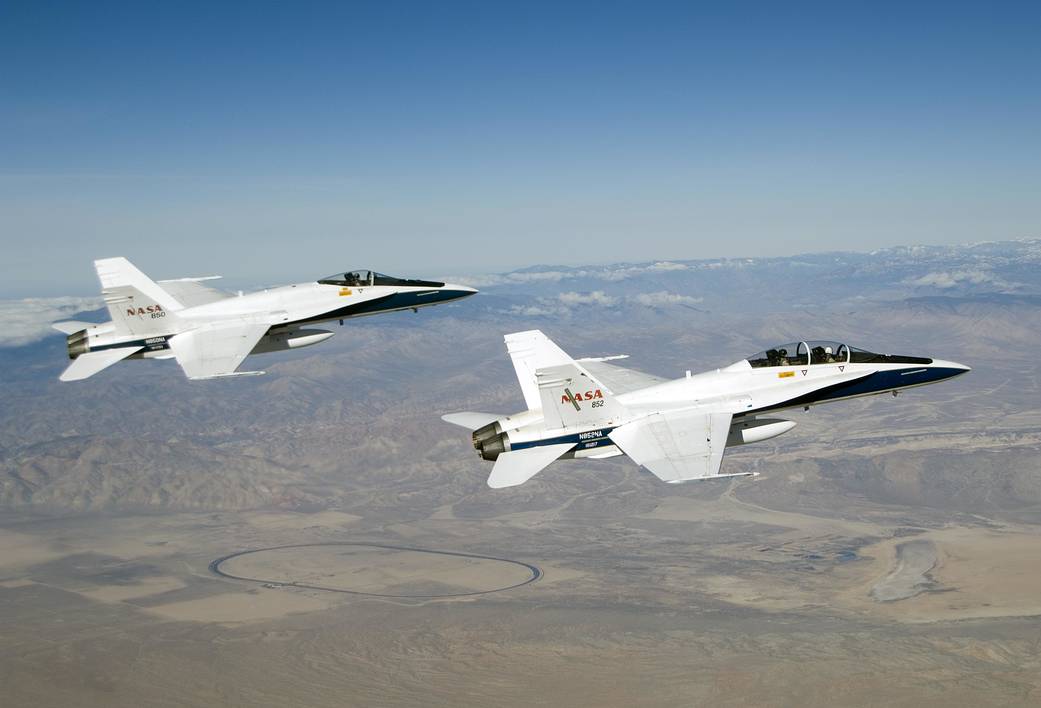In this Dec. 21, 2007 photograph, C. Gordon Fullerton capped an almost 50-year flying career, including more than 38 years with NASA, with a final flight in a NASA F/A-18. Fullerton, who was a NASA astronaut, research pilot and Air Force test pilot, died Aug. 21, 2013. He was 76.
On this mission, Fullerton and Dryden research pilot Jim Smolka flew a 90-minute pilot proficiency formation aerobatics flight with another Dryden F/A-18 and a Dryden T-38, concluding with two low-level formation flyovers of NASA’s Dryden Flight Research Center before landing. Fullerton was honored with a water-cannon spray arch provided by two fire trucks from the Edwards Air Force Base fire department as he taxied the F/A-18 up to the Dryden ramp, and was then greeted by his wife Marie and several hundred Dryden staff after his final flight.
Fullerton began his flying career with the U.S. Air Force in 1958 after earning bachelor’s and master’s degrees in mechanical engineering from the California Institute of Technology. Initially trained as a fighter pilot, he later transitioned to multi-engine bombers and became a bomber operations test pilot after attending the Air Force Aerospace Research Pilot School at Edwards Air Force Base, Calif. He then was assigned to the flight crew for the planned Air Force Manned Orbital Laboratory in 1966. Upon cancellation of that program, the Air Force assigned Fullerton to NASA’s astronaut corps in 1969.
He served on the support crews for the Apollo 14, 15, 16 and 17 lunar missions, and was later assigned to one of the two flight crews that piloted the space shuttle prototype Enterprise during the Approach and Landing Test program at Dryden. He then logged some 382 hours in space when he flew on two early space shuttle missions, STS-3 on Columbia in 1982 and STS-51F on Challenger in 1985. He joined the flight crew branch at NASA Dryden after leaving the astronaut corps in 1986. During his 21 years at Dryden, Fullerton was project pilot on a number of high-profile research efforts, including the Propulsion Controlled Aircraft, the high-speed landing tests of space shuttle landing gear components installed on a modified Convair 990 jetliner, the C-140 JetStar Laminar Flow Control, F-111 Mission Adaptive Wing, F-14 Variable Sweep Flow Transition, X-29 Vortex Flow Control, the Russian Tu-144LL supersonic transport evaluation and Dryden’s F-18 Systems Research Aircraft projects.
He also was project pilot for a number of research projects involving Dryden’s now-retired B-52B mothership, and piloted NASA’s DC-8 science laboratory on world-wide missions. Fullerton also served as Associate Director of Flight Operations and chief of the flight crew branch in later years. During his long career, Fullerton logged more than 16,000 flying hours. He retired from the Air Force in 1988 as a colonel after 30 years of active service. Fullerton was inducted into the Astronaut Hall of Fame in 2005, and the International Space Hall of Fame in 1982. His retirement from NASA was effective Dec. 31, 2007.
Image Credit: NASA/Jim Ross





























